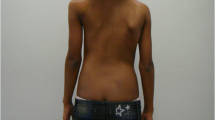Abstract
To establish the extent to which the paraspinal muscles are affected in idiopathic scoliosis, samples from patients must be compared with controls of a similar gender and age. To date, insufficient control data has been available for these purposes. The aim of this study was to redress this tissue, in order to identify whether one side of the apex of the scoliotic curve showed greater muscular abnormalities than the other. Bilateral samples of the paraspinal muscles were obtained during surgery from 14 female scoliosis patients, at the apex of the scoliotic curve at T9–T11. Percutaneous muscle biopsy samples were obtained from nine female volunteers, on the left side of the spine at T10. Samples were prepared for routine histochemistry for the identification of muscle fibre types. Fibre size was measured using computerised image analysis. Compared with control muscle, there was a significantly lower proportion of type I (slow-twitch oxidative) fibres in the muscle on the concave side of the scoliotic curve, but no difference on the convex side. The proportion of type IIB (fast-twitch, glycolytic) fibres was higher on both sides of the curve compared with controls, with the effect being significantly more marked on the concave side. The percentage of type IIA (slow-twitch, oxidative-glycolytic) fibres did not differ between the groups, and neither did fibre size (although there was a tendency for the controls to have larger type IIA fibres than the patients). Collectively, the differences in fibre type size and distribution meant that on the concave side the relative area of the muscle occupied by type I fibres was smaller, and on both sides of the curve the relative area occupied by type IIB fibres was greater and by type IIA fibres smaller, in comparison with controls. In scoliosis, the spinal musculature is most affected on the concave side of the curve’s apex. The muscle adopts a ‘faster’, or more ‘glycolytic’ profile, which would be consistent with a reduced low-level tonic activity of the muscle, perhaps consequent to a local change in activity on this side of the spine following progression of the curve. Less marked changes, in the same direction, are also evident on the convex side; these may be the result of general disuse of the paraspinal muscles associated with the spinal deformity.
Similar content being viewed by others
Author information
Authors and Affiliations
Additional information
Received: 12 November 1997 Accepted: 2 March 1998
Rights and permissions
About this article
Cite this article
Mannion, A., Meier, M., Grob, D. et al. Paraspinal muscle fibre type alterations associated with scoliosis: an old problem revisited with new evidence. E Spine J 7, 289–293 (1998). https://doi.org/10.1007/s005860050077
Issue Date:
DOI: https://doi.org/10.1007/s005860050077




